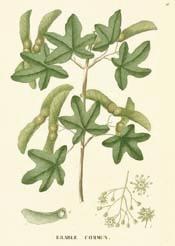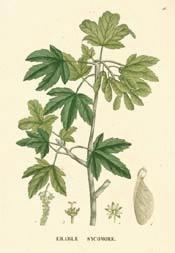
Botanical.com Home Page
MaplesFamily: N.O. Aceraceae---Habitat---The Maples, belonging to the genus Acer, natural order Aceraceae, are for the most part trees, inhabitants of the temperate regions of the Northern Hemisphere, particularly North America, Northern India and Japan.
---Description---The leaves are long-stalked, placed opposite to one another, and palmately lobed; the flowers, in fascicles appearing before the leaves as in the Norway Maple, or in racemes appearing with, or later than, the leaves as in the Sycamore Some of the flowers are often imperfect. The dry fruit, termed a 'samara,' is composed of two one-seeded cells, furnished with wings, which divide when ripe, the winged seeds being borne by the wind to a considerable distance. The leaves of the Maples commonly exhibit varnish-like smears, of sticky consistence, known as honey-dew. This is the excretion of the aphides which live on the leaves; the insect bores holes into the tissues, sucks their juices and ejects a drop of honeydew, on an average once in half an hour. In passing under a tree infested with aphides the drops can be felt like a fine rain. The fluid is rich in sugar. When the dew falls, the honey-dew takes it up and spreads over the leaf; later in the day evaporation reduces it to the state of a varnish on the leaf surface, which aids in checking transpiration. Many other trees exhibit this phenomenon, e.g. lime, beech, oak, etc. Most of the Maples yield a saccharine juice from the trunk, branches and leaves. The wood of almost all the species is useful for many purposes, especially to the cabinetmaker, the turner and the musical instrument-maker, and for the manufacture of alkali the Maples of North America are of great value. Many species with finely-cut or variegated leaves have been introduced, especially from Japan, as ornamental shrubs, most of them remarkable for the coppery-purple tint that pervades the leaves and younger growths. The Common Maple (Acer campestre, Linn.) is the only species indigenous to Great Britain. This and the Sycamore, or Great Maple, were described by Gerard in 1597, the latter as 'a stranger to England.' [Top] MAPLE, COMMON
Botanical: Acer campestreThough a native tree, Acer campestre is not often seen growing freely for the sake of its timber, being chiefly looked upon as a valuable hedge-tree, and is therefore frequently found in hedgerows.When growing alone it is a small tree, seldom attaining more than 20 feet, but the wood is compact, of a fine grain, sometimes beautifully veined and takes a high polish. For this reason, it is highly praised by the cabinet-maker and has always been used much for tables, also for inlaying, and is frequently employed for violin cases. The wood makes excellent fuel and affords very good charcoal. The wood of the roots is often knotted and is valuable for small objects of cabinet-work. The young shoots, being flexible and tough, are employed in France as whips. Sap drawn from the trees in spring yields a certain amount of sugar. [Top]
MAPLE, BIRD'S EYEAcer saccharinum (LINN.)Acer saccharinum (Linn.), the Sugar or Bird's Eye Maple, is an American species, introduced into Britain in 1735.It bears a considerable resemblance to the Norway Maple, especially when young, but is not so hardy here as our native Maple and requires a sheltered situation. So far it has only been grown as an ornamental tree, the vivid colours of its foliage in winter ranging from bright orange to dark crimson. Sometimes it attains a height of 70, or even 100 feet, though more commonly it does not exceed 50 or 60 feet. It is remarkable for the whiteness of its bark. Where the tree is plentiful in America, the timber is much used for fuel and is extensively employed for house-building and furniture, used instead of Oak when the latter is scarce, being also employed for axletrees and spokes, as well as for Windsor chairs, shoe-lasts, etc. The wood is white, but acquires a rosy tinge after exposure to light. The grain is fine and close and when polished has a silky lustre. The wood of old trees is valued for inlaying mahogany. The name 'Bird's Eye Maple' refers to the twisting of the silver grain, which produces numerous knots like the eyes of birds. Considerable quantities of this Maple are imported from Canada for cabinetmaking. The wood forms excellent fuel and charcoal, while the ashes are rich in alkaline principles, furnishing a large proportion of the potash exported from Boston and New York. Large quantities of sugar are made from the sap of this species of Maple. The sap is boiled and the syrup when reduced to a proper consistence is run into moulds to form cakes. Trees growing in moist and low situations afford the most sap, though the least proportion of sugar. The trees are tapped in early spring, just before the foliage develops, either by making a notch in the stem, about 3 feet from the ground, with an axe, or by boring a hole about 2 inches deep and introducing a spout of sumach or elder, through which the sap flows into a trough below. The sap is purified and concentrated in a simple manner, the whole work being carried on by farmers, who themselves use much of the product for domestic and culinary purposes. A cold north-west wind with frosty nights and sunny days tends to incite the flow, which is more abundant during the day than during the night. The flow ceases during a south-west wind and at the approach of a storm, and so sensitive are the trees to aspect and climatic variations that the flow of sap on the south and east sides has been noticed to be earlier than on the north and west sides of the same tree. The sap continues flowing for five or six weeks, according to the temperature. A tree of average size yields 15 to 30 gallons of sap in a season, 4 gallons of sap giving about 1 Ib. of sugar. The tree is not at all injured by the tapping operation. The quality of Maple Sugar is superior to that of West Indian cane sugar: it deposits less sediment when dissolved in water and has more the appearance of sugar candy. The profits of the Sugar Maple do not arise from the sugar alone: it affords good molasses and excellent vinegar. The sap which is suitable for these purposes is obtained after that which supplies the sugar has ceased to flow. [Top] MAPLE, GREAT
Botanical: Acer pseudo-Platanus (LINN.)Acer pseudo-Platanus (Linn.), the Sycamore or Great Maple (the Plane-tree of the Scotch), grows wild in Switzerland, Germany, Austria and Italy. It is remarkably hardy and will grow with an erect stem, exposed to the highest winds or to the sea-breezes, which it withstands better than most timber trees, being often planted near farmhouses and cottages in exposed localities for the sake of its dense foliage.---Description---It is a handsome tree, of quick growth, attaining a height of 50 or 60 feet in 50 years. Though not a native, it has been cultivated here for four or five centuries, and has become so naturalized that self-sown examples are common. The timber was formerly much used by the turner for cups, bowls and pattern blocks; and is still in repute by the saddlemakers and the millwright, being soft, light and tough. In spring and autumn, if the trunk is pierced, it yields an abundance of juice, from which a good wine has been made in the Highlands of Scotland. Sugar is to a certain extent procured from it by evaporation, but 1 ounce to 1 quart of sap is the largest amount of sugar obtainable. The leaves may be dried and given to sheep in winter. The lobed shape of its leaf and its dense foliage caused it to be confounded with the True Sycamore (Ficus sycamorus) of Scripture. [Top] MAPLE, NORWAYBotanical: Acer PlatanoidesAcer Platanoides, the Norway Maple, grows on the mountains of the northern countries of Europe, descending in some parts of Norway to the seashore. It abounds in the north of Poland and Lithuania, and is common through Germany, Switzerland, and Savoy.It was introduced into Great Britain in 1683. It is a quick grower and on a tolerable soil it attains a large size (from 40 to 70 feet). ---Description---The leaves are smooth and of a shining green, as large or larger than those of the Sycamore, and are seldom eaten or defaced, because the tree is full of a sharp, milky juice disliked by insects. In the spring, when the flowers, which are of a fine yellow colour, are out, this tree has great beauty. The wood is used for the same purposes as that of the Sycamore. Sugar has been made from the sap in Norway and Sweden. [Top] MAPLE, REDBotanical: Acer rubrum (LINN.)---Synonyms---Swamp Maple. Curled Maple. Acer rubrum (Linn.), the Red or Swamp Maple, is another American species, a middle-sized tree, introduced here in 1656, but so far only cultivated in England as an ornamental tree, for the sake of its striking bright scarlet flowers, which appear before the leaves in March and April, its red fruit and leaves rendering it very attractive also in autumn.The wood is applicable to many purposes, such as the seats of Windsor chairs, turnery, etc. The grain of very old trees is sometimes undulated, which has suggested the name of 'Curled Maple': this gives beautiful effects of light and shade on polished surfaces. The most constant use of Curled Maple is for the stocks of fowling pieces and rifles, as it affords toughness and strength, combined with lightness and elegance, but on the whole the wood is considered inferior to that of the Bird's Eye Maple, both in strength and as fuel. Sugar has been made from the sap by the French Canadians, and also molasses, but the yield is only half as great as that from the Sugar Maple. The inner bark is dusky red: on boiling, it yields a purple colour, which with sulphate of lead affords a black dye. It makes a good black ink. ---Medicinal Action and Uses---The bark has astringent properties and has been used medicinally as an application for sore eyes, a use which the early settlers learnt from the Red Indians. It occurs in long quilled pieces 6 to 12 inches or more in length, 1/4 to 3/4 inch wide, externally blackish brown, slightly polished, with innumerable fine transverse lines and scattered, brownish, warts. The inner bark is in very tough and fibrous layers, pale reddish brown or buff. The bark has an astringent and slightly bitter taste. The CHINESE SUGAR MAPLE is Sorghum saccharatum (known also as Andropogon arundinaceus, var. saccharatus), a cane-like plant containing sugary sap, belonging to the Grass family Graminaceae. It somewhat resembles Indian corn, or maize, from which it is distinguished by producing large heads of small grains. It is cultivated in the United States to some extent as a forage crop, but is not used in the manufacture of sugar, owing to the difficulty of effecting its crystallization. [Top] © Copyright Protected 1995-2025 Botanical.com
|

